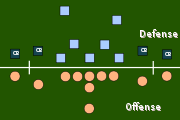
Dimeback
Encyclopedia

American football
American football is a sport played between two teams of eleven with the objective of scoring points by advancing the ball into the opposing team's end zone. Known in the United States simply as football, it may also be referred to informally as gridiron football. The ball can be advanced by...
, a dimeback is a cornerback
Cornerback
A cornerback is a member of the defensive backfield or secondary in American and Canadian football. Cornerbacks cover receivers, to defend against pass offenses and make tackles. Other members of the defensive backfield include the safeties and occasionally linebackers. The cornerback position...
who serves as the sixth defensive back (fourth cornerback) on defense. The third cornerback on defense is known as a nickelback
Nickelback (position)
In American football, a nickelback is a cornerback who serves as the fifth defensive back on the defense. A base defense contains four defensive backs, consisting of two cornerbacks, and two safeties. Adding an extra back makes five, hence the term "nickel", which is the name for 5-cent coins in...
. The dimeback position is essentially relegated to backup cornerbacks who do not play starting cornerback positions. Dimebacks are usually fast players because they must be able to keep up on passing plays with 3+ wide receiver
Wide receiver
A wide receiver is an offensive position in American and Canadian football, and is the key player in most of the passing plays. Only players in the backfield or the ends on the line are eligible to catch a forward pass. The two players who begin play at the ends of the offensive line are eligible...
s.
Dimebacks are brought into the game when the defense uses a "Dime" formation, which utilizes six defensive backs rather than four or five. Usually, a dimeback replaces a linebacker
Linebacker
A linebacker is a position in American football that was invented by football coach Fielding H. Yost of the University of Michigan. Linebackers are members of the defensive team, and line up approximately three to five yards behind the line of scrimmage, behind the defensive linemen...
in order to gain better pass defense.

